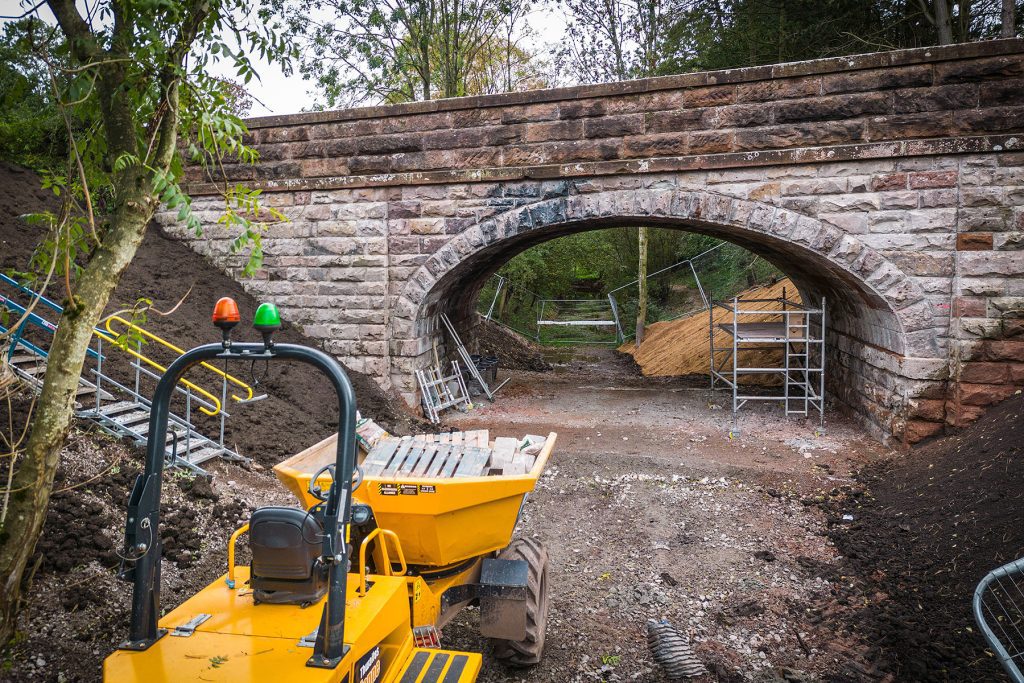A Victorian railway bridge in Cumbria’s Eden Valley, which National Highways infilled amidst claims it was weak, is set to reopen without a weight restriction or any form of strengthening being needed.
The masonry arch structure at Great Musgrave, engineered by Sir Thomas Bouch in the early 1860s, has been closed for 13 weeks whilst 1,600 tonnes of stone and concrete were removed from around it to comply with an enforcement notice – the deadline for which was yesterday (Wednesday 11 October) – issued by the now-disbanded Eden District Council following refusal of a retrospective planning application.
In June 2021, the state-owned roads company caused controversy by exploiting emergency permitted development rights to bury the 160-year-old structure despite planning officers asking for work not to start. National Highways’ engineer claimed that “the bridge was being overloaded and that works were required to prevent the failure of the bridge and avert a collapse.” However, just 16 months earlier, an inspection found only a small number of minor defects, with NH recording the structure as presenting “no significant risk” to public safety.
As recently as six weeks ago, National Highways had claimed that it needed to “carry out additional necessary strengthening work so the bridge can continue being used safely by the public”. However, after a new capacity assessment was completed, the company has admitted that its “refurbishment work” – which has only involved localised repointing and repairs to stonework damage caused by excavation of the concrete infill – “will remove the need for a weight restriction, restoring the bridge to full capacity.”
According to campaigners, there is no meaningful difference between the condition of the bridge now and how it was before infilling.
“It’s a breath-taking turnaround by National Highways”, says Graeme Bickerdike, a member of The HRE Group of engineers, heritage campaigners and greenway developers. “For the past two years, they’ve told anyone who’ll listen that the bridge was weak and infilling was necessary for safety reasons. But this contradicted all the available engineering evidence.
“The new theoretical capacity assessment changes nothing in practical terms. They knew that the bridge was fine – or, at least, they should have – on the basis of inspection insight. But they contrived an alternative reality about a potential collapse to justify what, in truth, was an opportunistic act of vandalism for liability reduction purposes, facilitated by the local council’s initial acceptance that the work could be carried out as permitted development.
“It’s been a costly shambles from start to finish and the taxpayer has a right to understand the circumstances. The bridge’s return to its rightful place as a historic landscape asset is welcome, but the fact that no strengthening was needed completely undermines National Highways.”
The company has not yet published the new capacity assessment or revealed the cost of removing the infill. It had set aside £431K for the work, but this included a strengthening scheme which has proved to be unnecessary. £124K was paid to contractor AmcoGiffen for the original infilling.
The blockage at Great Musgrave threatened to derail the longstanding plans of two heritage railways to reopen the line under the bridge as part of a five-mile link between their bases at Warcop and Kirkby Stephen East stations. They were not consulted about the infilling, contrary to statements by National Highways.
“The first we knew about it was when one of our volunteers drove over the bridge and discovered that the contractor had set up a compound”, says Mike Thompson, Project Manager with the Stainmore Railway Company. “We were powerless; everyone connected with the operation here felt angry, upset and bullied.
“We’re obviously pleased that the bridge has been restored to its previous state so we can again focus on our extension northwards. But to discover that this whole shabby affair was for nothing sticks in the throat. How was it allowed to happen? Where was the oversight? It raises important questions about National Highways’ culture, honesty and competence, and therefore its suitability as the custodian of our legacy railway assets.”
Meanwhile, National Highways has made clear its intention to appeal after the Borough Council of King’s Lynn & West Norfolk refused the company’s retrospective planning application for the infilling of a historic bridge in Norfolk. The structure, on St Andrew’s Lane at Congham near King’s Lynn, was the last surviving complete example of a bridge built using a system of modular concrete components first introduced by the eminent engineer William Marriott. It was infilled under emergency permitted development rights in spring 2021, at a cost of £127K.






